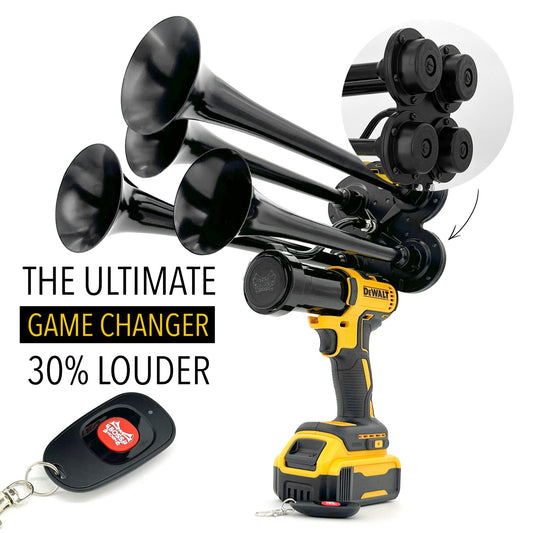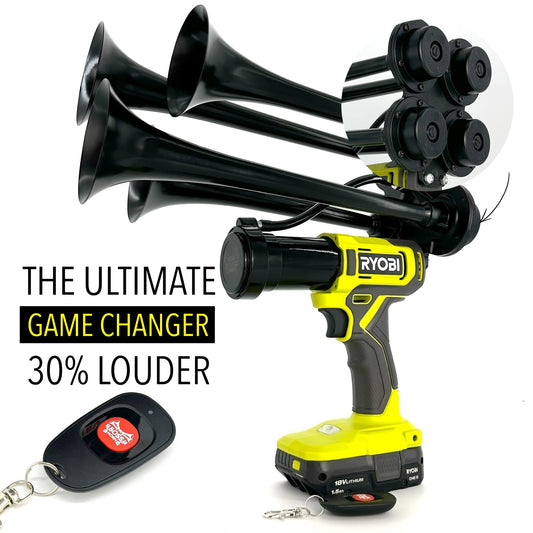An air horn is a powerful acoustic device used to create a loud noise by releasing compressed air through a horn-shaped nozzle. The noise produced by an air horn can reach incredibly high decibel levels, making it an effective tool for alerting people in emergency situations or attracting attention in large, noisy environments.
Originally developed for maritime use in the early 1900s, air horns have evolved into versatile devices that find applications in various industries today. Whether it is signaling the departure of a large vessel, alerting workers in construction sites, or enhancing the safety measures during sporting events, the loudness of an air horn plays a crucial role in its effectiveness.
When considering the volume of an air horn, it is essential to understand decibels (dB), the unit used to measure sound intensity. To put things into perspective, a whisper might reach around 30 dB, while a normal conversation usually registers around 60 dB. However, air horns can generate sound levels well above these everyday examples. For instance, some air horns can produce noise at volumes reaching 120 dB, equivalent to the noise level of a rock concert or a thunderclap.
Given the high decibel levels air horns can produce, it is crucial to exercise caution when using them. Prolonged exposure to loud noises can result in hearing damage or even permanent hearing loss. Therefore, it is recommended to wear hearing protection if exposed to prolonged or intense noise levels, such as those generated by air horns.
In conclusion, air horns are powerful acoustic devices that generate loud signals by releasing compressed air through a horn-shaped nozzle. Their ability to reach high decibel levels makes them effective tools in emergency situations and noisy environments alike. However, it is important to prioritize safety and protect one's hearing when using air horns or when exposed to their loud noise.
Air Horn Decibel Levels: Understanding the Intensity and Impact of Sound Amplification
When it comes to assessing the volume of an air horn, determining its loudness can be a subjective matter as it depends on various factors such as the specific model, distance from the source, and the environment in which it is used. However, decibel (dB) levels are commonly employed to measure sound intensity and provide a standardized metric for comparison. In this article, we delve into the definitions of decibel levels, their relevance in gauging the loudness of air horns, and the implications of their intensity. Stay tuned to explore the fascinating world of air horn decibel levels, their potential advantages, and the associated implications in different scenarios.
Decibels: The Measurement of Sound
When it comes to measuring sound, the unit used is decibels (dB). Decibels indicate the intensity or loudness of a sound. Generally, the higher the decibel level, the louder the sound. For reference, a typical conversation ranges around 60 dB, while a rock concert can reach 120 dB.
The Sound of an Air Horn
An air horn is a powerful device that emits a loud sound by discharging compressed air. These horns are commonly used in various settings, such as sporting events, emergency situations, or as a safety device on boats. But just how loud can an air horn be?
The average air horn can produce a sound level that ranges between 120 to 150 dB, depending on the specific model and air pressure. To put that into perspective, 120 dB is equivalent to the noise level of a chainsaw, while 150 dB is similar to a jet engine taking off.
Impact on Hearing
Exposure to high decibel levels, including those produced by air horns, can have detrimental effects on our hearing. Prolonged exposure to sounds above 85 dB can lead to hearing damage and even permanent hearing loss. It is vital to use proper hearing protection when exposed to intense sounds like those emitted by air horns.
Legal Restrictions
Due to the potential harm caused by loud noises, there are legal restrictions on the use of air horns in certain areas. In some jurisdictions, the use of air horns is only allowed in specific situations, such as emergencies or sporting events. It is crucial to familiarize yourself with local laws and regulations regarding the use of air horns to avoid any legal consequences.
Protecting Your Hearing
If you find yourself in a situation where you need to use an air horn, it is essential to take precautions to protect your hearing and those around you. Make sure to wear hearing protection, such as earplugs or earmuffs, to minimize the risk of hearing damage. Additionally, avoid prolonged exposure to loud sounds and maintain a safe distance from the source of the noise.
Statistics
- The average air horn produces a sound level of 120 to 150 decibels.
- Exposure to sounds above 85 decibels can cause hearing damage.
https://youtube.com/watch?v=3sFKRFLsraU
Frequently Asked Questions about the Loudness of Air Horns
1. What are air horns commonly used for?
Air horns are commonly used for a variety of purposes. They are frequently seen in sporting events, especially in outdoor stadiums, where they are used to generate enthusiasm and cheer for the home team. Additionally, air horns are commonly used in boating and maritime activities as a signal to communicate messages across long distances. They are also utilized in industries such as construction and manufacturing to alert workers or to signal emergencies.
Important information:
a) Air horns are often used for creating excitement and support at sporting events.
b) They serve as effective signaling devices in the maritime industry.
c) Air horns can be used for emergency situations in different industries.
2. How do air horns work?
Air horns operate based on a simple principle. Compressed air or gas, usually stored in a canister, is released through a narrow opening or a small horn-shaped tube when a valve or button is pressed. As the air flows through this opening, it creates vibrations in the surrounding air molecules, which generates sound waves at a specific frequency. The longer the duration for which the valve or button is held and the greater the amount of compressed air released, the louder the resulting sound.
Important information:
a) Air horns function by releasing compressed air or gas through an opening.
b) The release of air generates vibrations that produce sound waves.
c) The volume of the sound produced depends on the duration and amount of air released.
3. Are air horns louder than regular horns?
Yes, air horns are significantly louder than regular horns typically found in vehicles. While the loudness of regular horns can vary depending on their design and power source, they are generally limited due to size and the voltage supplied by a vehicle's electrical system. On the other hand, air horns are specifically designed to create loud and attention-grabbing sounds. Their larger size, use of compressed air, and specialized construction allow them to produce volumes that can reach well over 100 decibels (dB). This makes air horns ideal for situations where a powerful and piercing sound is required.
Important information:
a) Air horns are much louder than regular vehicle horns.
b) Regular horns are limited in loudness by their size and power source.
c) Air horns have the ability to produce volumes that exceed 100 decibels.
4. Can air horns cause any hearing damage?
Yes, prolonged exposure to the loud sound produced by air horns can potentially cause hearing damage. Sound volume is measured in decibels (dB), and exposure to sounds above 85 dB for an extended period can negatively impact hearing. As mentioned earlier, air horns can exceed 100 dB, especially when used in close proximity. Therefore, it is important to exercise caution and limit exposure to the high-intensity sound produced by air horns. Proper usage techniques and adhering to recommended safety guidelines are crucial to prevent hearing impairment.
Important information:
a) Prolonged exposure to air horns' sound can potentially damage hearing.
b) Sound volumes above 85 dB can have a negative impact on hearing.
c) Air horns can exceed 100 dB, emphasizing the importance of caution and following safety guidelines.
5. Are there any regulations or restrictions on the use of air horns?
Yes, the use of air horns is subject to regulations and restrictions in various jurisdictions. In many areas, the loudness and duration of air horn usage are regulated to ensure they are used responsibly and not as a nuisance. These regulations may apply to specific locations, such as residential areas or certain times of the day, to minimize disturbance to the public. It is crucial to familiarize oneself with the local laws and regulations governing the use of air horns to avoid any legal consequences or inconvenience.
Important information:
a) There are regulations and restrictions on the use of air horns in different jurisdictions.
b) These regulations typically aim to prevent air horn usage as a nuisance.
c) It is important to be aware of and comply with local laws and regulations regarding air horn usage.
Conclusion
After evaluating the loudness of an air horn, it can be concluded that air horns are exceptionally loud devices designed to produce an intense and attention-grabbing sound. These instruments are commonly used in various applications, such as sports events, emergency signaling, and marine safety.
Key Points:
- An air horn can produce sound levels ranging from 120 to 150 decibels (dB), depending on its design and construction.
- At a distance of one meter, a standard air horn can reach sound levels of around 130-140 dB, equivalent to a jet engine at takeoff.
- The high sound pressure levels generated by air horns make them extremely effective for alerting people in emergency situations and attracting immediate attention.
- It is essential to use air horns responsibly, ensuring that they are not excessively loud to avoid causing discomfort, hearing damage, or violating local noise regulations.
- Air horns should be used sparingly and only when necessary to prevent noise pollution and potential health risks.
Insights:
- The loudness of an air horn is mainly determined by the volume of air released, the design of the horn, and the compressed air pressure used.
- Air horns are most commonly powered by compressed gas, usually in the form of a canister or a built-in pump system, which allows for instantaneous sound production.
- The sound intensity of an air horn can be affected by factors such as atmospheric conditions, sound reflection, and the surrounding environment.
- When using an air horn, it is important to follow safety precautions, such as avoiding directing the sound towards individuals' ears, especially at close range.
- Due to their primary function of producing loud sounds, air horns should not be used for recreational purposes or as toys, especially in proximity to others.














